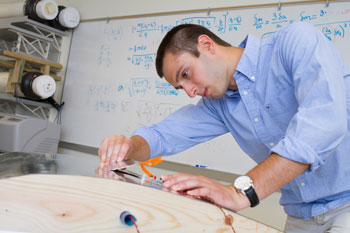Physicists at Longwood University are examining a new way of tapping wind power to create electricity by making vehicles more efficient.
The research harnesses the wind that passes over an airfoil—an object shaped in the familiar cross-sectional shape of an airplane wing. Dr. Chuck Ross, dean of the Cook-Cole College of Arts and Sciences, and junior physics student Garrett Josemans designed and tested the prototype, which proves the concept could work. A set of holes in the bottom of the wing and a flap on top create a channel for air to move through the structure as well as around. The air moving through the channel turns a fan inside the wing, which can potentially generate enough energy to charge a battery.
"It’s a unique concept," said Ross. "Exploring alternative energy sources and streamlining the efficiency of vehicles are key components of advancing energy technology. This is a unique concept that we believe has not been explored before, and it may lead to some new ideas."
The key principle of the energy-producing prototype is the same feature that keeps airplanes in the air. The shape of an airfoil produces higher pressure underneath the wing, which provides the lift that keeps airplanes aloft. The channel Ross and Josemans incorporated into the airfoil uses the pressure difference to guide air past the fan, essentially turning it into a wind turbine for creating electricity.
Further testing is required to determine if the system is efficient enough for practical use—the wind needs to be moving quickly enough to drive the fan to output significant electrical current. If the model turns out to have practical applications, Ross and Josemans said it could be integrated into many different types of vehicles: cars, trains and even boats—anything that could generate enough air current to turn the fan. "If this idea could be made to work on a practical level, it would be an interesting alternative source of energy on various moving vehicles or in particularly windy areas," said Ross.
Could the device be integrated into an airplane wing? If the disruption of airflow caused by the interior channel doesn’t significantly alter the stability of the aircraft, it may be a possibility.
In the airline industry, alternative sources of energy are being investigated by major organizations to curb fuel costs, which have led to higher ticket prices. Ross and Josemans don’t think the energy generated would be enough to offset rising fuel prices, but the impact could be significant. "The potential of this design is pretty extensive," said Josemans. "If the design could be made efficient enough, the fan could charge batteries that could be used to light the airplane cabin or other systems that require energy."



Leave a Comment